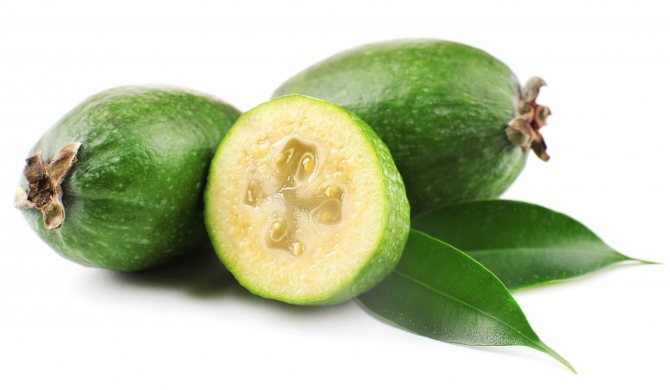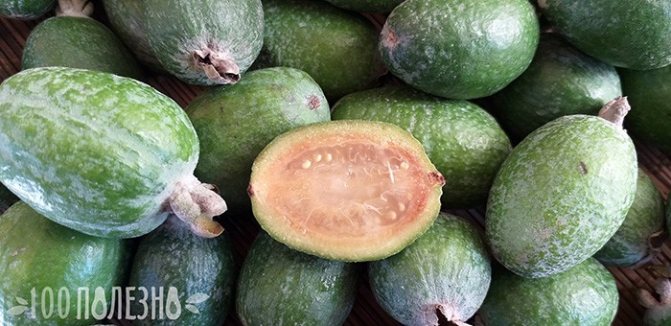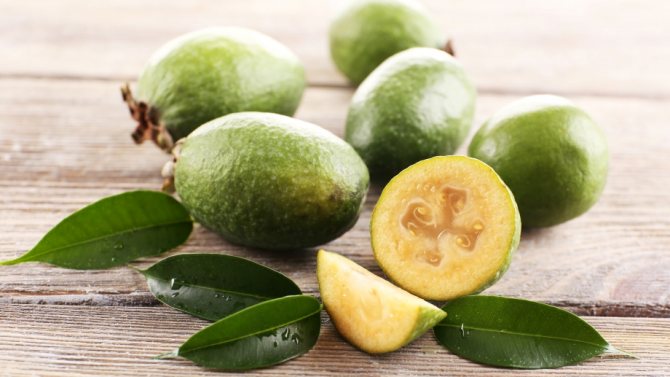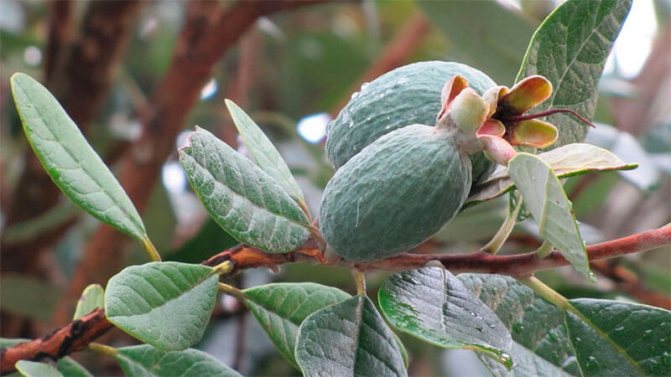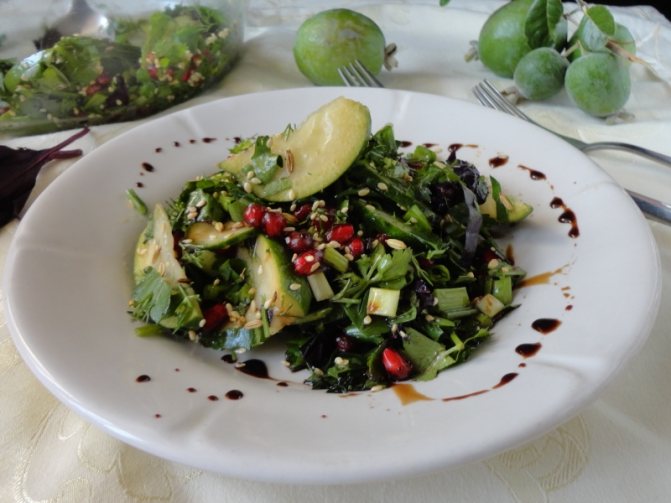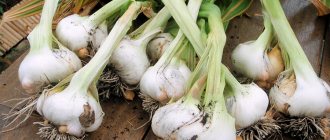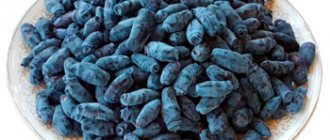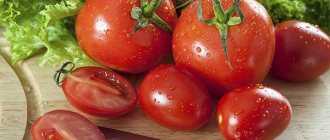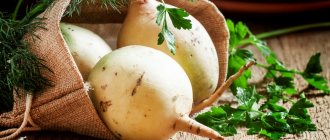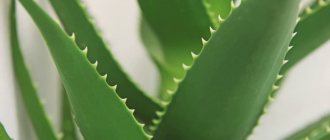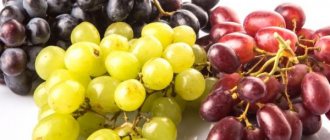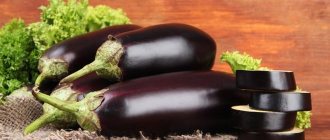The small feijoa tree is distinguished by huge white flowers with a whole sheaf of red elongated stamens. Their petals are edible and delicious in desserts, salads and tea. But most of all, the plant comes from Brazil, where it is pollinated by tiny hummingbirds for tasty and healthy fruits.

Calorie content and chemical composition
Feijoa has a low calorie content: 100 g of raw product contains only 55 kcal.
The composition of the fruits is represented (in 100 g) by the following substances:
- water - 84.94 g;
- carbohydrates - 12.9 g;
- dietary fiber - 6.4 g;
- proteins - 1.0 g;
- fats - 0.6 g;
- ash - 0.56 g.
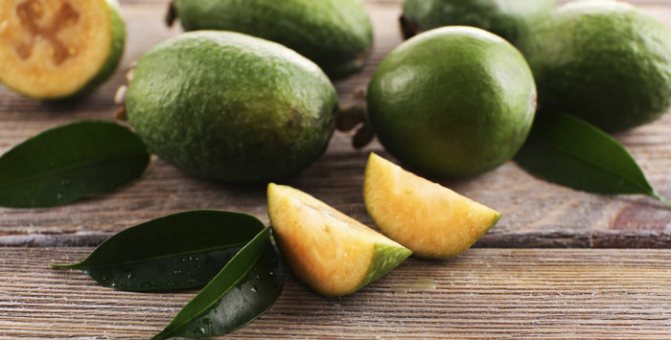

Vitamins:
- C - 32.9 mg;
- PP - 0.295 mg;
- B5 - 0.233 mg;
- B6 - 0.067 mg;
- E (alpha-tocopherol) - 0.16 mg;
- E (gamma-tocopherol) - 0.03 mg;
- lutein and zeaxanthin - 0.027 mg;
- B9 - 0.023 mg;
- B2 - 0.018 mg;
- B1 - 0.006 mg;
- lycopene - 0.005 mg;
- K - 0.0035 mg;
- beta-cryptoxanthin - 0.003 mg;
- beta-carotene - 0.002 mg.
Minerals:
- potassium - 172 mg;
- phosphorus - 19 mg;
- calcium - 17 mg;
- magnesium - 9 mg;
- iodine - 8.0 mg;
- sodium - 3 mg;
- iron - 0.14 mg;
- manganese - 0.084 mg;
- zinc - 0.06 mg;
- copper - 0.036 mg.
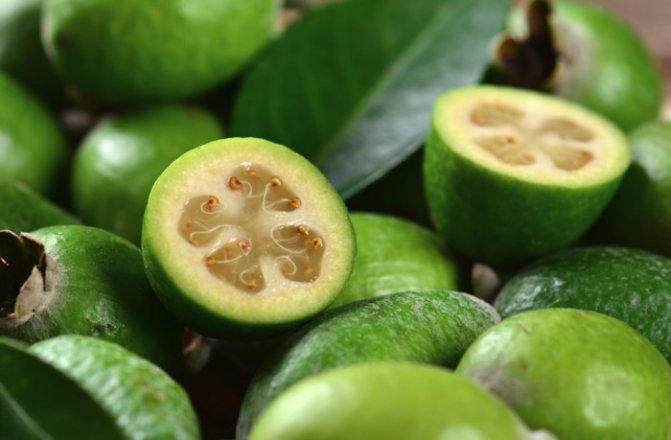

This exotic fruit also contains 10 essential amino acids and 8 nonessential fatty acids (Omega-3 and Omega-6). This berry is also rich in fruit acids and pectins, and contains essential oils.
Did you know?
Feijoa is native to the subtropics of Latin America. To the territory of Europe (To France) the fruit was introduced in 1890. This evergreen shrub (tree) got its name from the surname of the Portuguese Juan da Silva Feijo, a naturalist who was the first to tell the world about this plant.
Varieties and types of cultural feijoa
The efforts of breeders are aimed at breeding more winter-hardy varieties.
The following varieties are popular:
- Early fragrant - small fruits with a refreshing sour taste, and a pronounced "iodine" aroma, grow only up to 13 cm in diameter, but the variety is fruitful,
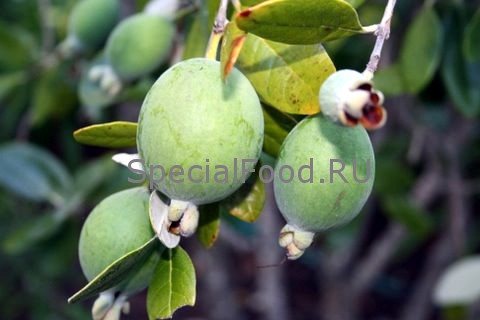

the plant is literally sprinkled with feijoa. - Firstborn - slightly larger berries, up to 20 cm in diameter, and later ripening. This variety bears fruit until early December.
- Nikitsky - large-fruited feijoa, grow up to 40 g, have a sweet taste, most of all remind strawberries for connoisseurs.
- Hilly - the fruits resemble some kind of exotic fruit, have different shapes, from oval to absolutely round, and are quite large, reaching 38 g.
Feijoa species differ in terms of fruit ripening time, distinguish varieties of early, middle and late ripeness.
Why feijoa berry is useful for the body
Due to the above saturated composition, this fruit has a number of beneficial properties for the human body:
- 100 g contains a 53-day dose of iodine. Even seafood does not contain such an amount of this microelement, which is important for the thyroid gland. This content of iodine, together with other substances, helps to normalize metabolism;
- improves immunity, as it contains a lot of vitamin C;
- it is recommended to use it for vitamin deficiency, as it contains a wide variety of vitamins;
- many of the substances contained in this fruit have antioxidant properties;
- has a preventive effect against cancer;
- useful for atherosclerosis, hypertension;
- improves blood counts (lowers cholesterol, increases hemoglobin);
- has a beneficial effect on digestion:
- has anti-inflammatory effect;
- stimulates mental activity.
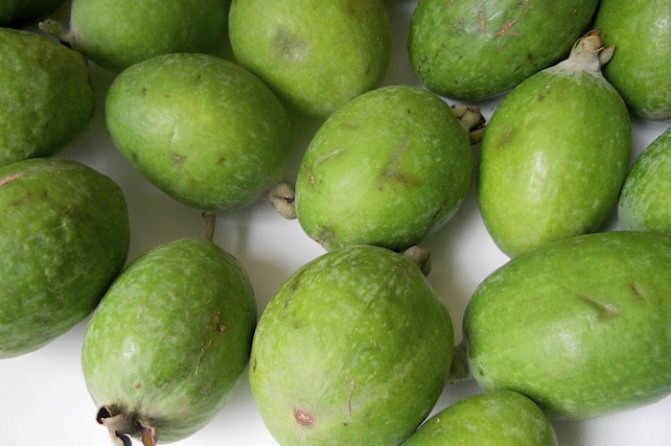

Benefits for women
These fruits bring the following benefits to the female body:
- have a rejuvenating effect on the body thanks to antioxidants;
- help to lose extra pounds, as they contain few calories, normalize metabolism and stimulate digestion;
- improve hormonal levels, therefore have a beneficial effect on libido and the reproductive system;
- are an excellent cosmetic product in face masks (rejuvenation, whitening).
Feijoa can be eaten by pregnant women. Iodine, a group of B vitamins, iron and other substances contained in the berry have a positive effect on the formation of the fruit. At the twelfth week of development, his thyroid gland begins to form, and the use of feijoa will be most beneficial. But do not abuse it - everything is good in moderation.
It will also be useful for nursing mothers, but for the first three months after childbirth it is better to refrain from using it in order to avoid allergies in infants. It should first be included in the diet in small portions and observe the baby's reactions. If there are no allergic manifestations, then you can increase the dose to half the fetus per day, no more.


Benefits for men
For men, feijoa will also be useful due to the following properties:
- increases libido;
- improves the functioning of the reproductive system;
- is the prevention of prostatitis, and its oncoprotective properties will be useful in the presence of prostate adenoma.
Recommendations for use
Feijoa is best eaten fresh. Unfortunately, the product is stored no longer than a week, so it is allowed to eat jam or other dishes that retain the beneficial properties of the fruit.
Unripe or overripe berries will not benefit the body, use only a ripe product.
Before eating, the fruits should be washed well and the tails should be cut off. You should not peel off the peel, as it contains the maximum amount of trace elements. Feijoa can be eaten at any time of the day. The optimal daily allowance is two large fruits for an adult and one for a child. With iodine deficiency, it is recommended to eat 3 - 5 berries per day.
How to choose when buying and store
In order to get the necessary benefits from these exotic fruits, the following should be considered:
- usually they are transported to other countries unripe, but they can ripen at home;
- choose fruits without rot, damage and suspicious stains;
- good quality berries have a rich green color: if they are darkened, yellowed or covered with brown specks or spots, then it is better to refrain from buying;
- squeeze the fruit a little in your hand - it should be evenly elastic and not have dents, a slight softness in the entire fruit is permissible;
- if possible, cut the berry and see what color it is inside: fruits with a white interior should ripen, feijoa with transparent pulp can already be eaten, and it is recommended to refuse eating a fruit with a brownish tone.


Important!
Feijoa, when ripening in an apartment, do not lose their useful properties. If you bought hard fruits, then you should give them time to ripen in a dark place and become soft. Such a fruit will become tastier and more aromatic, inside it looks like jelly.
Selection rules
The following tips will help you buy ripe feijoa:
- Flesh color: transparent. The interior of overripe fruit is brown, while unripe fruit is white.
- Flesh texture: soft, jelly-like consistency.
- Skin color: uniform, dark green without black spots and signs of decay.
- Surface: matt with rough edges.
- Peduncle: absent, which indicates the natural ripening of the berry.
- Taste: juicy pulp has a specific acidity with a slight smell of iodine.
The large diameter of the pineapple guava is not an indicator of maturity. The size of the fruit depends on the variety.
As it is
The taste and smell of feijoa fruits are found to be similar to strawberries, pineapple and kiwi. As an independent dish, the fruit is cut in half and the pulp is scraped out with a spoon. Only the pulp is used to make puddings and ice cream.
But many useful substances are concentrated in the grated skin, so it is more advisable to add this fruit to a salad, cut it into cubes along with the skin, or make some vitamin cocktail or puree with it.
A healthy dessert that provides you with vitamins and minerals for a long time will be grated feijoa with sugar and stored in the refrigerator. So many people harvest raspberries.
If after the feijoa there is a cut or scraped skin left, then it can be thrown into a compote or added to tea.


Feijoa for weight loss
Due to its low calorie content, the berry can be included in the diet. It fills the body with useful substances during the period of a strict diet, strengthens the immune system, improves metabolism, due to which weight loss occurs faster. It is advisable to eat one fruit before each meal. You can replace the usual snack foods in the evening with a berry.
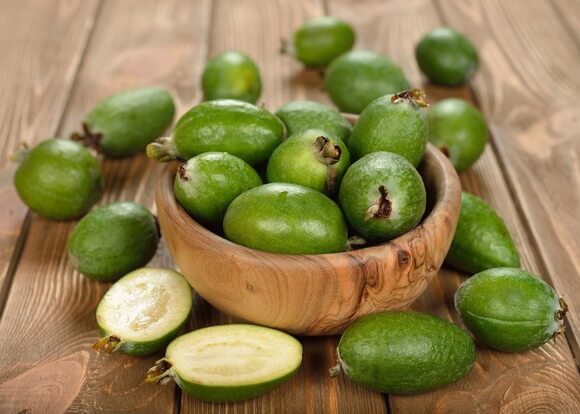

Contraindications and harm
In some cases, these berries should not be consumed:
- with an excess of iodine in the body;
- with diabetes: before using these fruits, you should consult a doctor;
- with allergies: individual intolerance to feijoa is quite rare, but it should be borne in mind that these fruits are unusual for the inhabitants of our latitudes;
- children under one year old;
- these berries do not combine with milk and can cause stomach upset.
You should also not eat too much of this product. It will be helpful in moderation.
Contraindications to the use of feijoa
This incredibly healthy fruit still has contraindications. It is recommended to completely abandon or limit consumption when:
- diabetes;
- allergies;
- hyperthyroidism;
- obesity.
Everything ingenious is simple. Once again, you are convinced of this by looking at the outwardly nondescript feijoa fruit. But what a valuable treasure is hidden inside. But remember, everything is fine in moderation. The desire to quickly saturate the body with vitamins will not lead to anything good, on the contrary, it can harm.
In folk medicine
The use of feijoa will be beneficial for such ailments:
- hypothyroidism, Graves' disease;
- a weak immune system;
- anemia;
- high cholesterol;
- diseases of the cardiovascular system;
- constipation;
- rheumatism;
- pain during menstruation;
- avitaminosis;
- colds, flu, bronchitis;
- acne, pimples;
- iodine deficiency.
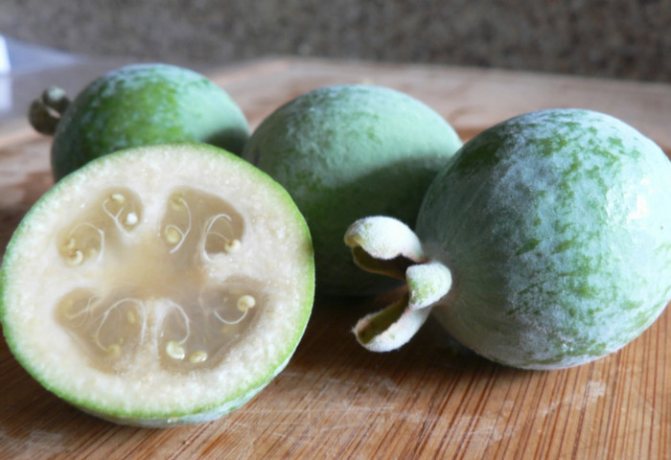

Important!
Iodine deficiency diseases are, according to WHO, the most common among diseases that are not caused by infection. They are especially dangerous for the mental development of the child (including in the womb). The risk group includes residents of mountains and areas remote from the sea, smokers and alcoholics, people who have undergone radiation exposure, and pregnant women. In 2011, iodine deficiency was identified by research in 70% of the British.
Health recipes
With the help of these berries, you can improve your health. For medicinal purposes, the leaves and flowers of the plant are also used.
For heart
To strengthen the muscles of the heart and improve cardiovascular activity, it is recommended to eat fresh juice from the fruits of this plant.... To do this, dissolve 1 tbsp in ¼ glass of water. l. berry juice. The prepared medicine is taken once a day.
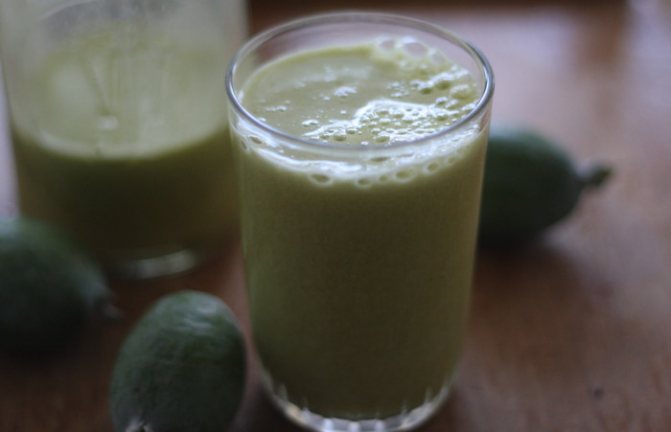

For joints
For inflammatory processes in the joints, feijoa jam with orange is recommended. To do this, 0.5 kg of feijoa fruits (the peel is not cut off) is crushed using a blender. Then the resulting mass is transferred into a saucepan, 1 kg of sugar is added.
Then boil over low heat for 10 minutes from the moment of boiling. After that, freshly squeezed orange juice from one large fruit is added and brought to a boil. Poured into sterile storage containers. Such jam can be stored for a year even at room conditions.
The jam has not only healthy, but also excellent taste.This product is very helpful for atherosclerosis, vitamin deficiency and low immunity.
For the thyroid gland
The amount of iodine in these exotic fruits is no less than in seafood. Therefore, they are great for treating thyroid diseases caused by iodine deficiency. For this purpose, mashed potatoes are made from berries. To prepare it, take 300 g of fruit, wash and, without peeling off the skin, grind it through a meat grinder or grind it with a blender. This mass is recommended to be consumed one tablespoon on an empty stomach.
When treating goiter, it is useful to take tea from the leaves of this plant. For this purpose, 1 tbsp. l. crushed fresh leaves, pour 250 g of boiling water and let it brew for half an hour. Take one glass twice a day, you can add honey.
Pressure normalization
To normalize pressure, it is recommended to take a mixture of berries. For this, 1 tbsp. l. pre-chopped fruit is mixed with 1 tbsp. l. granulated sugar.
This mixture is taken 2 times a day (in the morning and in the evening) for 30 g.


With hepatitis A
For hepatitis A, the following feijoa tea recipe is recommended. To cook it, 1 tbsp. l. a mixture of dry inflorescences and leaves of this plant is poured with 250 g of boiling water. Let it brew for 30 minutes.
This tea is recommended to be taken twice a day.
With jade and jaundice
Tea from flowers and leaves of this exotic plant helps with jade and jaundice. For this, 1 tsp. raw materials are poured with boiling water and insisted for 20 minutes. You can add honey for taste. This tea is taken throughout the day.
To improve immunity
For general strengthening of the body and immunity for the whole family, you can use the following recipe.
Take 1 kg of feijoa, wash and grind with a blender or meat grinder. Then add 1 kg of sugar, mix well and place in clean jars, seal with lids. Take such a remedy one teaspoon at a meal.
What are the beneficial properties
Feijoa berries are capable of providing a preventive and therapeutic effect in pathologies:
- atherosclerosis;
- inflammation of the thyroid gland;
- avitaminosis;
- blockage of blood vessels;
- gastritis;
- acute and chronic diseases of the gastrointestinal tract;
- aggravated pyelonephritis.
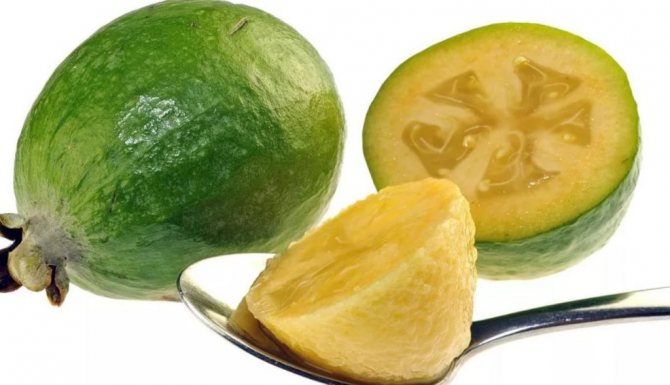

Ripe pulp is suitable for making ice cream and cocktails
For medicinal purposes, fresh fruits are used, crushed to a puree state, or prepared tinctures and decoctions.
Feijoa peel contains strong antioxidants - catechins and leukoanthocyanins. They stop the aging of the body and reduce the likelihood of developing cancer.
Women's health benefits
Quechua is a low-calorie product, so it can be consumed in the diet. It contains biologically active elements that accelerate metabolism and promote the rapid elimination of toxins from the body. Feijoa can complement any diet for women who want to lose weight quickly.
Cooking applications
Feijoa is widely used in cooking. It is used for making salads, sauces, jellies, preserves, jams, etc. This berry goes well with meat or fish. Feijoa juice or cocktail is considered useful. The berry can be added to compotes, teas.
Any dishes made from feijoa have not only unusual taste, but are also a source of vitamins and useful elements.
Feijoa vitamin puree
Vitamin puree from feijoa is very tasty and healthy.
To prepare it, you will need the following ingredients:
- 0.5 kg feijoa;
- 0.25 kg of liquid honey or 0.3 kg of sugar;
- 1 lime;
- mint - a few branches.
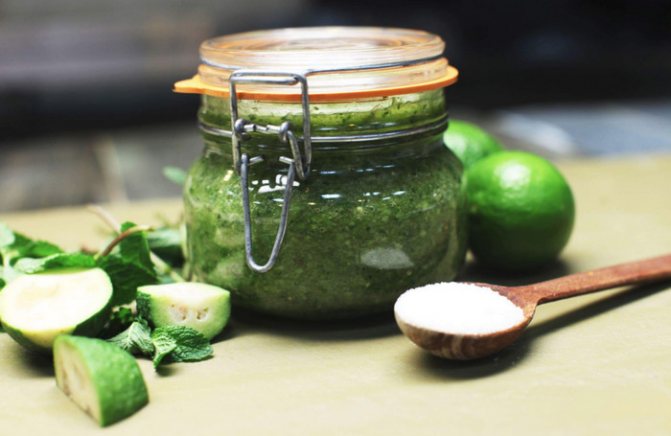

The cooking method is as follows:
- Wash feijoa, lime and mint well and then dry.
- Twist all the ingredients in a meat grinder or grind with a blender.
- Thoroughly grind the resulting mixture with honey (sugar) and transfer to a pre-sterilized jar.
This jam is a storehouse of vitamins, especially vitamin C. To strengthen the immune system, it is recommended to use one teaspoon for breakfast every morning.
This product can be stored on a refrigerator shelf for no more than 3-4 weeks.
Whole Feijoa Jam
Whole feijoa jam with lemon is tasty and healthy.
Video: how to make feijoa jam
To prepare it, you will need the following ingredients:
- 0.5 kg feijoa;
- 1 tbsp. Sahara;
- 0.5 l of water;
- 1 tsp cognac.
To make such a jam, you should follow these steps:
- Wash the feijoa, clean it and fill it with water (put the cleaning aside).
- Heat and melt 1/2 of the sugar in a skillet until brown.
- Remove the pan with sugar from the heat and add 0.5 liters of boiling water after half a minute. Stir well, add purification, bring to a boil and cook for 7 minutes.
- Drain the syrup and add the remaining sugar and peeled berries. Cook for 35 minutes with a quiet boil, stirring occasionally.
- Add cognac at the end.
- Arrange in pre-sterilized jars, roll up the lids and put in a cool place.
This jam, like any other, is stored in a cool dry place throughout the year. A cellar or pantry works well, but can be stored in a kitchen cabinet as well.
This jam is recommended for the prevention of viral diseases.


Did you know?
In 1900, feijoa were introduced and cultivated in Crimea and Abkhazia. Now they are also grown by Armenia, Georgia, Azerbaijan, Turkmenistan, France and all the countries of the Mediterranean. The fruit also spread to the Pacific coast of the United States, New Zealand and Australia. Can withstand temperatures as low as -11 ° C.
Feijoa cocktail
A very large amount of vitamins is found in the feijoa cocktail.
To prepare it, you will need the following ingredients:
- 2 pcs. feijoa;
- 2 pcs. kiwi;
- 150 ml of low-fat kefir or yogurt;
- 1 tsp honey.
Cooking method:
- Wash fruits, peel, cut into slices.
- Transfer to a blender and add kefir or yogurt, add honey.
- Grind with a blender and pour into glasses.
This cocktail should be drunk for breakfast in order to stock up on vitamins for the whole day.
It is not recommended to store it, so you need to drink it immediately after preparation.
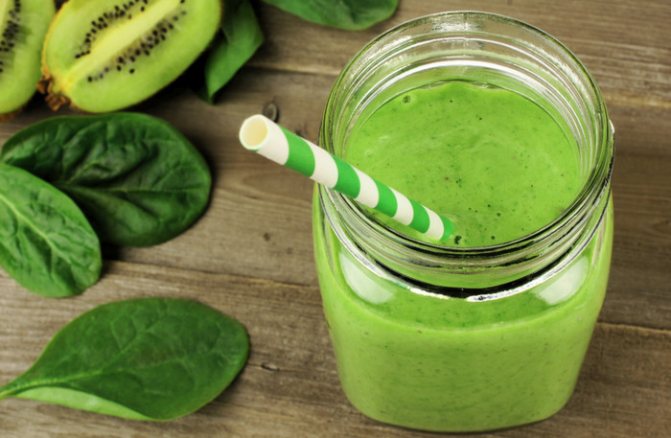

Jam from feijoa
Feijoa jam is made without boiling. Due to this, it contains a large amount of vitamins.
To prepare it, you will need the following ingredients:
- 1 kg feijoa;
- 1 kg of sugar.
To prepare this dish, you should take only ripe fruits.
Cooking method:
- Feijoa wash well and dry with a towel.
- Chop finely with a knife and sprinkle with sugar.
- Grind this mixture thoroughly with a wooden spatula.
- Place in clean jars, close the lid.
Storage is carried out in the refrigerator for 3-5 months. Sugar can be replaced with honey, then this jam will become even healthier.
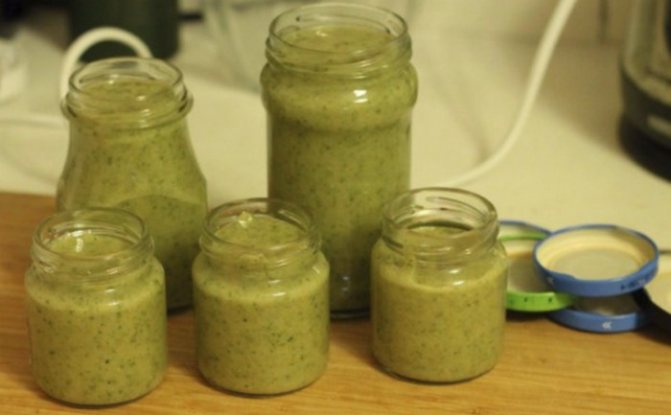

Feijoa - what is it? Description of the plant, photo
An evergreen, fairly tall (up to 4 m) shrub originates from Brazil. Today the plant is cultivated in Abkhazia, Azerbaijan, New Zealand. On the territory of Russia in Dagestan and Krasnodar region.
Flowering occurs in late spring. The flowers are very beautiful, with many long stamens, give the shrub an elegant look, and are pollinated by insects. The fruits ripen in mid-autumn.
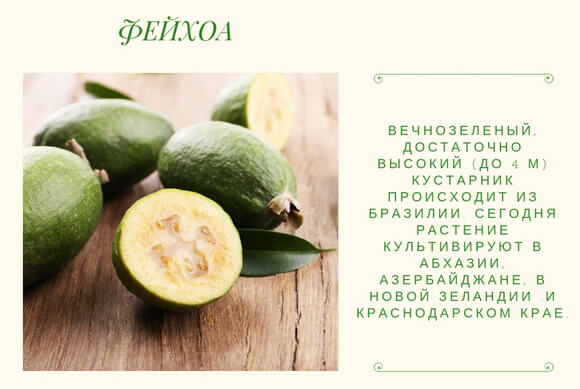

Feijoa berry or fruit?
Although consumers call the fruit feijoa, it is actually a berry. The oval fruit, up to 5 cm in diameter, has a fleshy milky flesh and a rich green peel covered with tubercles. Small dark achenes are edible. The taste and smell of the berry is a mixture of pineapple, kiwi and ripe strawberries.
Application in cosmetology and dermatology
Feijoa masks are very beneficial for the skin due to the content of the following beneficial substances:
- vitamins of group C and B perfectly nourish the skin, improve its color, and also protect it from pollution and negative environmental influences;
- sucrose helps to moisturize and nourish the skin;
- pectins relieve inflammation, regulate the sebaceous glands;
- fiber activates the production of elastin and collagen, which contributes to skin rejuvenation;
- essential oil prevents redness and dryness of the skin;
- malic acid fights well with oily sheen;
- iodine strengthens the skin, it becomes smoother and more elastic.
Feijoa masks are very useful for all skin types. They are applied to previously cleansed skin and kept for no more than 20 minutes.
Rejuvenating mask
A rejuvenating feijoa mask will help smooth out wrinkles and increase skin elasticity.
To prepare it, you need the following ingredients:
- 2 tbsp. l. feijoa pulp;
- 1 tsp honey;
- 1 tsp vegetable oil (better than olive, but you can also sunflower).
Mask preparation method:
- Mix all ingredients.
- Distribute the resulting mass evenly over the face, neck and décolleté.
- After 10-15 minutes, remove the remnants of the mask with a paper towel and rinse with warm water.


Did you know?
You should know that the amount of iodine in feijoa fruits is related to the conditions of the area where they grow. With a lack of iodine in the soil or growing at home, the berries will not contain a large amount of this trace element. The largest amount of iodine is found in fruits grown on the seaside.
Mask for dry skin
For dry skin, a nourishing feijoa mask can help.
To prepare it, you need the following ingredients:
- 1 tbsp. l. feijoa pulp;
- 1 tsp castor oil;
- 1 tsp heavy cream.
Mask preparation method:
- Mix all ingredients until puree.
- Distribute the resulting mass evenly over the face and neck.
- After 10-15 minutes, remove the mask with warm water.
Mask for oily skin
A mask for oily skin from feijoa helps against greasy shine and acne.
To prepare it, you need the following ingredients:
- 1 tbsp. l. feijoa pulp;
- 1 tsp camphor alcohol;
- 1 tsp lemon juice.
Mask preparation method:
- Mix all ingredients until a puree mixture is obtained.
- Spread the resulting mixture evenly over the face.
- After 15-20 minutes, remove the mask by rinsing with warm water.
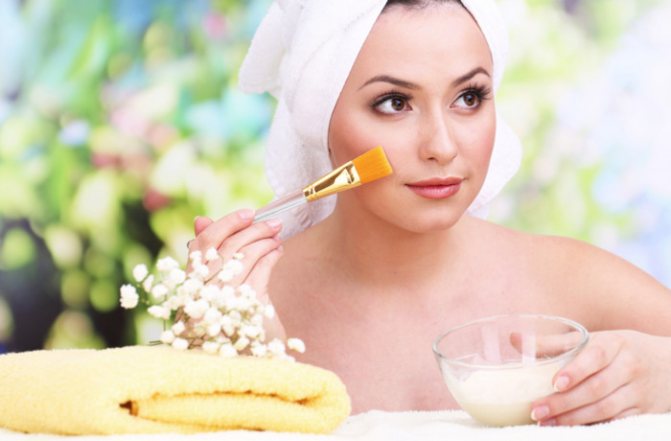

Universal mask
A universal mask is well suited for all skin types, which improves complexion, tightens and nourishes the skin.
To prepare it, you need the following ingredients:
- 1-2 tbsp. l. feijoa pulp;
- 1 chicken egg;
- 1 tsp vegetable oil (preferably olive oil).
Mask preparation method:
- Stir all ingredients until a homogeneous mixture is obtained.
- Spread the resulting mixture evenly over the skin.
- After 20 minutes, remove the mask by rinsing with warm water.
Feijoa is a valuable product for the prevention of iodine deficiency. The concentration of iodine in it is so high that even the use of a small amount of these fruits will help to avoid many problems. The use of berries and the use of infusions of leaves and flowers will help in the treatment of many diseases. In addition, delicious and healthy dishes can be prepared from this berry. Therefore, do not pass by this useful fruit!

